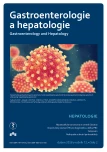Treatment of an adenoma of the ascending colon with the non-lifting sign via a combination of endoscopic mucosal resection and full-thickness resection
Authors:
P. Falt 1–3; R. Andělová 3; O. Urban 1–3
Authors‘ workplace:
Centrum péče o zažívací trakt, Vítkovická nemocnice a. s., Ostrava
1; Katedra interních oborů, LF UK v Hradci Králové
2; LF OU v Ostravě
3; Oddělení patologie, Nemocnice Nový Jičín
4
Published in:
Gastroent Hepatol 2018; 72(2): 148-151
Category:
Digestive Endoscopy: Case Report
doi:
https://doi.org/10.14735/amgh2018csgh.info03
Overview
Endoscopic full-thickness resection (FTR) is a novel technique for transmural resection of the large intestine. The main indications are local residual neoplasia and neoplasia with the non-lifting sign that cannot be treated by standard endoscopic resection. FTR may be limited because larger lesions cannot be drawn into the cap. We present a 58-year-old patient with a superficial neoplastic lesion measuring 30 mm in the ascending colon with central depression and the non-lifting sign that was diagnosed by a screening colonoscopy. A combination of endoscopic mucosal resection of the lateral parts and FTR of the central part with the non-lifting sign was performed without any complications. Histological examination demonstrated complete resection of a tubular adenoma with high-grade intraepithelial neoplasia.
Key words:
colorectal carcinoma – adenoma – full-thickness resection – endoscopic mucosal resection
The authors declare they have no potential conflicts of interest concerning drugs, products, or services used in the study.
The Editorial Board declares that the manuscript met the ICMJE „uniform requirements“ for biomedical papers.
Sources
1. Schmidt A, Meier B, Caca K. Endoscopic full-thickness resection: current status. World J Gastroenterol 2015; 21 (31): 9273–9285.
2. Falt P, Urban O, Hanousek M et al. „Full-thickness“ endoskopická resekce lokální reziduální neoplazie v hepatální flexuře – videokazuistika. Gastroent Hepatol 2016; 70 (5): 398–401. doi: 10.14735/amgh2016398.
3. Falt P, Štěpán M, Andělová R et al. Kombinace endoskopické slizniční resekce a transmurální resekce v léčbě lokálních reziduálních neoplazií tračníku – popis dvou případů. Rozhl Chir 2017; 96 (9): 394–398.
4. Schmidt A, Beyna T, Schumacher B et al. Colonoscopic full-thickness resection using an over-the-scope device: a prospective multicentre study in various indications. Gut 2017. In press. doi: 10.1136/gutjnl-2016-313677.
5. Meier B, Caca K, Schmidt A. Hybrid endoscopic mucosal resection and full-thickness resection: a new approach for resection of large non-lifting colorectal adenomas (with video). Surg Endosc 2017; 31 (10): 4268–4274. doi: 10.1007/s00464-017-5461-9.
6. Moss A, Bourke MJ, Williams SJ et al. Endoscopic mucosal resection outcomes and prediction of submucosal cancer from advanced colonic mucosal neoplasia. Gastroenterology 2011; 140 (7): 1909–1918. doi: 10.1053/j.gastro.2011.02.062
Labels
Paediatric gastroenterology Gastroenterology and hepatology Surgery Internal medicine Nutritive therapist ObesitologyArticle was published in
Gastroenterology and Hepatology

2018 Issue 2
Most read in this issue
- Terlipressin remains indispensable in two indications
- Guidelines of the Czech Society of Hepatology for diagnosis and treatment of primary biliary cholangitis
- Hepatic cyst infection as a source of sepsis in liver polycystosis
- A rare cause of increased abdominal size
